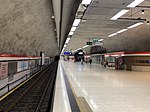Hämäläis-Osakunta
Europe university stubsFinnish building and structure stubsStudent nations in Greater Helsinki
Hämäläis-Osakunta (HO, colloquially Hämis) is one of the 15 student nations at the University of Helsinki, Finnish-speaking and established in 1653 at The Royal Academy of Turku. In 1828, the Academy moved to Helsinki adopting the name university and Hämäläis-Osakunta moved there along with the other nations. HO represents the historic region of Tavastia (nowadays, roughly Pirkanmaa, Tavastia Proper and Päijänne Tavastia), so it recruits its members actively there. The building of the nation, built in 1931, is located in Kamppi, on Urho Kekkosen katu.
Excerpt from the Wikipedia article Hämäläis-Osakunta (License: CC BY-SA 3.0, Authors).Hämäläis-Osakunta
Urho Kekkosen katu, Helsinki Kamppi (Southern major district)
Geographical coordinates (GPS) Address Nearby Places Show on map
Geographical coordinates (GPS)
| Latitude | Longitude |
|---|---|
| N 60.168611111111 ° | E 24.933055555556 ° |
Address
Urho Kekkosen katu 4-6
00100 Helsinki, Kamppi (Southern major district)
Finland
Open on Google Maps









